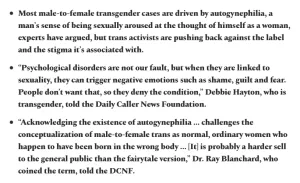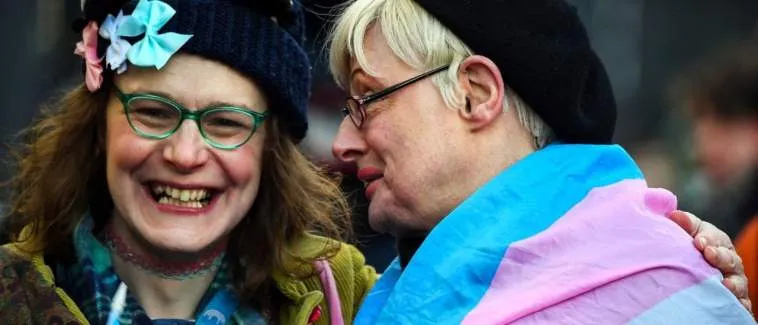
(Daily Caller) Autogynephilia, or a man’s condition of being sexually aroused by the concept of himself as a woman, is a driving force behind male-to-female transgenderism, according to some experts, but activists and a leading transgender medical group have been reluctant to acknowledge the issue.
The World Professional Association for Transgender Health (WPATH), the leading transgender medical organization, removed the term from its standards of care between 1998 and 2001, and proponents of the transgender movement have decriedthe term as inaccurate and stigmatizing.
Autogynephilia, or AGP, undercuts the narrative pushed by proponents of transgender ideology that gender transitions aren’t sexual, and a significant proportion of transgender people are heterosexual men who are sexually aroused when they present themselves as female and wear women’s clothing, researchers and transgender people have argued.
AGP drives the overwhelming majority of male-to-female transsexual cases, according to Dr. Ray Blanchard, a Canadian psychiatry professor who coined the term in the late 1980s. Most of the pushback against the classification of AGP comes from transgender activists and their allies in the mental health field rather than from medical institutions, he said.
“Acknowledging the existence of autogynephilia creates certain problems,” Blanchard told the DCNF. “First, it challenges the conceptualization of male-to-female (MTF) trans as normal, ordinary women who happen to have been born in the wrong body. It threatens the rationale they may have used for terminating their marriages, for risking alienating their children, and sometimes for experiencing a career setback.”
“Secondly, the autogynephilia explanation of nonhomosexual gender dysphoria is probably a harder sell to the general public than the fairytale version,” he added.
I wonder if Blanchard was right? He suggested that most late transitioning MTFs were afflicted with autogynephilia of one type or another.
But the shame associated with AGP leads them to construct a magical female inner essence so they can live in denial.
Just a suggestion.
— Debbie Hayton 🏳️⚧️🏳️🌈 (@DebbieHayton) March 4, 2019
“I think it is important to understand, however, that some AGP individuals, with or without gender dysphoria, recognize themselves in clinical descriptions of AGP, and some are even relieved to learn that there are other men just like themselves. Furthermore, one of the very best scholarly works on autogynephilia was written by a postoperative [male to female] transsexual who is herself AGP, Dr. Anne A. Lawrence, MD,” Blanchard said.
Dr. Michael Bailey, a psychology professor at Northwestern University who is known for his research on biology and sexual orientation, told the DCNF he agreed with Blanchard that AGP motivates the majority of male-to-female transgender cases.
“Psychological disorders are not our fault, but when they are linked to sexuality, they can trigger negative emotions such as shame, guilt and fear,” Hayton told the DCNF. “People don’t want that, so they deny the condition. When you accept that you have AGP, you need to take responsibility for your condition. This is a psychological disorder that can be treated, but we need to accept that our condition has an impact (often negative) on other people. The alternative born-in-the-wrong-body idea is attractive because it makes us a victim of an unfortunate circumstance.”
Blanchard’s characterization of AGP is based in part on testimonials from dozens of autogynephiles collected by Dr. Anne Lawrence; these patients expressed sexual arousal at the thought of themselves as women beginning around puberty, according to Blanchard’s “Early History of the Concept of Autogynephilia” published in 2005 in the Archives of Sexual Behavior.
Some of the patients Lawrence interviewed expressed shame and disgust at their feelings of arousal. Others gave detailed accounts of arousal they experienced through cross-dressing and mimicking female bodily functions.
“Wearing women’s clothing and feminizing my body has always been sexually exciting for me—even after SRS [sex reassignment surgery],” one patient said. “[I]t was and still is sexually exciting for me to have female body ‘functions.’ Before my SRS, I would pretend to menstruate by urinating in sanitary pad. Even the idea of owning a girl’s bike has aroused me.”
‘Trans Activists’
However, the AGP theory is rarely mentioned, or is downplayed, by WPATH and prominent transgender activists.
“Those who requested genital reconstructive surgery more commonly had adolescent histories of fetishistic cross-dressing or autogynephilic fantasies without cross-dressing,” according WPATH’s 1998 standards of care. The term was removed from its standards of care by 2001, along with the reference to cross-dressing as a fetish.
Blanchard said transgender activists likely pushed WPATH to stop using the term, though the DCNF could not confirm this was the case.






